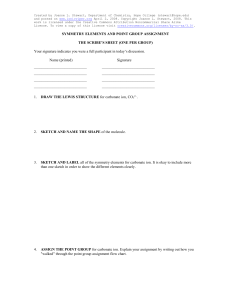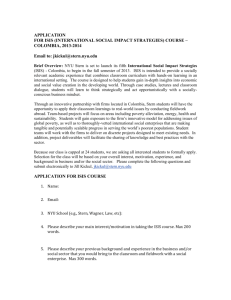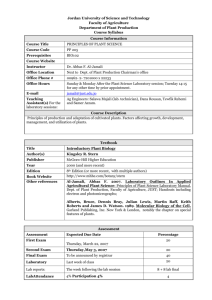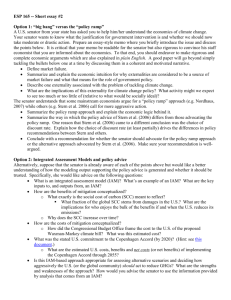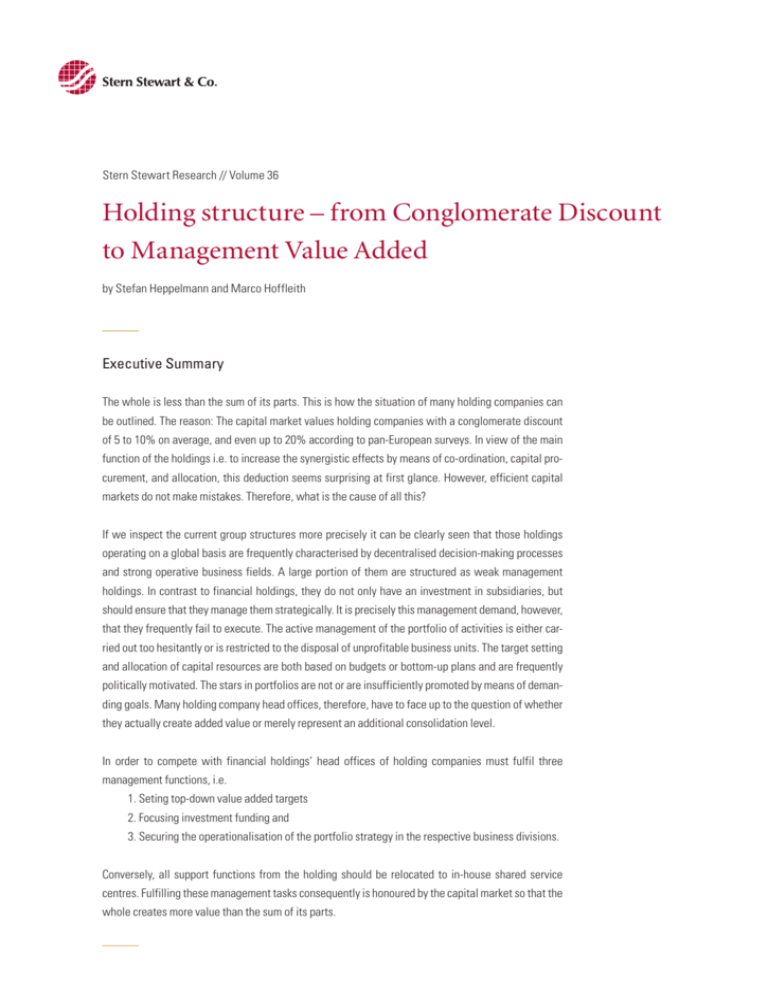
Stern Stewart Research // Volume 36
Holding structure – from Conglomerate Discount
to Management Value Added
by Stefan Heppelmann and Marco Hoffleith
Executive Summary
The whole is less than the sum of its parts. This is how the situation of many holding companies can
be outlined. The reason: The capital market values holding companies with a conglomerate discount
of 5 to 10% on average, and even up to 20% according to pan-European surveys. In view of the main
function of the holdings i.e. to increase the synergistic effects by means of co-ordination, capital procurement, and allocation, this deduction seems surprising at first glance. However, efficient capital
markets do not make mistakes. Therefore, what is the cause of all this?
If we inspect the current group structures more precisely it can be clearly seen that those holdings
operating on a global basis are frequently characterised by decentralised decision-making processes
and strong operative business fields. A large portion of them are structured as weak management
holdings. In contrast to financial holdings, they do not only have an investment in subsidiaries, but
should ensure that they manage them strategically. It is precisely this management demand, however,
that they frequently fail to execute. The active management of the portfolio of activities is either carried out too hesitantly or is restricted to the disposal of unprofitable business units. The target setting
and allocation of capital resources are both based on budgets or bottom-up plans and are frequently
politically motivated. The stars in portfolios are not or are insufficiently promoted by means of demanding goals. Many holding company head offices, therefore, have to face up to the question of whether
they actually create added value or merely represent an additional consolidation level.
In order to compete with financial holdings’ head offices of holding companies must fulfil three
management functions, i.e.
1. Seting top-down value added targets
2. Focusing investment funding and
3. Securing the operationalisation of the portfolio strategy in the respective business divisions.
Conversely, all support functions from the holding should be relocated to in-house shared service
centres. Fulfilling these management tasks consequently is honoured by the capital market so that the
whole creates more value than the sum of its parts.
The Conglomerate Discount – expression of dissatisfied capital markets
and a door opener for financial investors
On average, the Conglomerate Discount, i.e. the reduction in valuation by the capital market due to
Holdings are typically valued
the organisational merger of business fields in order to form holding amounts of 5 to 10% in general
with marked reductions on the
and up to 20% in those case studies based on European samples. To put it in another way:
capital market
The net effect, i.e. the difference between the added value of the holding tasks (drafting of the reports, optimisation of taxes, procurement of investment funding in the capital market, and cash
management) and the linked costs (overhead costs, slowing down of the decision making process
due to hierarchies – a variety of functions) is deemed negative. As a logical consequence of this, the
group sections are valued higher based on a stand-alone consideration compared to the group as
a whole.
This fact should be the cause of much worry for the board members of these holdings. The
The board must prove the
reduction in valuation is based solely on the chosen organisational structures and has nothing to
meaningfulness of the holding
do with the validity and sustainability of the group sector’s individual business models. Therefore,
structure
it must be permissible to question as to whether such holding structures are justifiable, which
evidently do not help in adding value. The consideration of the possible ways that such holdings can
be broken up is the consequence – particularly in view of the fact that spin-offs, buy outs, and
demergers of group sectors represent tangible alternatives. Financial investors are also attracted by
conglomerate discounts and in turn can act as catalysts of a potential break up. If the holding board
wants to pre-empt these kinds of scenarios, then it must convince investors and capital markets
of the meaningfulness of the holding as an organisational form.
The structure of the group head office is fundamentally dependent on the
holding’s management demand
The role of the holding structure has always had a mirror image of the management theories that,
The self-conception and claim
respectively, prevailed. In the 1970s and 1990s, for instance, it was an expression of the conviction
of holding leadership have
that was widely held at these times that a diversification effect due to different business fields in the
changed over the years.
portfolio would be advantageous. Nowadays, the holding structure is more of an expression of a
dynamic business fields’ portfolio, the changing composition of which is characterised by a con­
tinuous search for new growth fields in changing markets. The tasks of the group holding vary in this
case depending on their self-conception and claim to leadership, ranging from pure financing to the
specification of strategic guidelines and in turn extending to interference in operative business
activities.
© 2009 // All rights reserved for Stern Stewart & Co.
3
A holding from which no
A distinction must be made between the holding’s functions that it performs in order to categorise the
economic advantages can
holding’s management strength. In terms of its minimum function, the holding must perform tasks
be derived is unsuitable as
that guarantee its legal existence. These include, for instance, the consolidation of P&L accounts and
an organisational form
balance sheets, the preparation of annual financial statements, securing liquidity, the payment of
taxes and dividends, as well as the observation of all the statutory and regulatory provisions.
However, the extension of these functions beyond this scope should be integrated into the respective
actions in order to derive economic benefits. Otherwise, this would not be a meaningful structural
variant.
Between a dream and reality:
In October 2006, the Economist Intelligence Unit, a Research Tank of The Economist, published a survey
The dilemma between local
with the title “Global dreams, local realities – The challenge of managing multinationals”. This survey
autonomy and central control
confirmed the dilemma between local autonomy and central control that globally active groups are currently facing. Many group boards find it difficult to achieve this balancing act between the surrendering
of authority to the local management and the desire for control by means of centralisation. The survey,
which was conducted with nearly 300 executive participants, demonstrates a trend towards the de­
centralisation of functions such as sales, marketing, PR, and HR as well as towards centralisation in the
strategy, finance, and IT sectors.
The holding must make
The results of the survey confirm Stern Stewart & Co. belief that the inward and outward positioning
a sustained contribution
of the holding is ultimately determined by the scope of the central functions that have been
towards value creation in
assumed. The goal of every holding must be to provide a clearly recognisable added value. The pure
order to convince the
standardisation of processes and grouping of tasks for the purpose of increasing efficiency and
market
economy of scale benefits is insufficient to create sustained added value. On the other hand, the
clear separation into the control functions of the holding, operative corporate tasks for segments, as
well as support functions ensures a clearer self-conception of the individual units by means of their
contribution towards value added for the shareholders.
Holding functions, operative functions, support functions
C FO
C EO
Base
Chemicals
Polymer
Chemicals
CHRO
Shared Service
Centre for
- Personnel
- Accounting
Functional
Chemicals
Example of the chemicals industry
4
© 2009 // All rights reserved for Stern Stewart & Co.
Stern Stewart & Co. experiences demonstrate that a holding structure is only justified in economic
A holding is typically only wor-
terms if these management functions are performed:
thwhile in economic terms if it
performs central
I) Specification of value added goals for the business areas
management functions
II) Focusing of the investment funds
III) “Operationalisation” of the portfolio strategy.
The starting point of active portfolio management is to stipulate ambitious goal specifications for the
individual business fields that are based on the capital market expectations and competitors‘ per­
formance. Depending on the value added targets that have been derived, the holding‘s head office
must ensure that investment funds are directed into the business areas with the greatest levels of
potential. Once the value added targets and direction of the strategic thrust have been clearly
established, the holding must initiate the operationalisation of these specifications within the individual business areas: Within the framework of a value added agenda, the framework parameters are
stipulated and constantly monitored for the progress made. The measures are derived and initiated
at the level of the individual business areas.
I) Specification of value added goals for the business areas
Three clear structural questions are faced by the holding at the start of the process of value-based
It should be possible to
goal derivation:
measure the specification of
value oriented targets based on
1. What level of performance does the capital market anticipate from the business
capital market expectations
fields in the future?
2. What level of performance does the capital market anticipate from competitors
in the future?
3. How good is the present level of competition compared to the competition?
Through this process, the answering of these questions outlines the sequence of goal derivation.
However, in everyday business
However, in practice, the holding management rarely has an answer. The answers in response to the
life, you will rarely find such
simple question of where the goals within the company actually stem from are often sobering. The
capital market oriented systems
targets for the individual business fields are frequently based on the budget or the planning, and
thereby are driven bottom-up. Thus, the management’s own forecasts become the measuring gauge
in terms of the attainment of targets: The more conservative the budget planning is the greater the
likelihood that this yardstick will be successfully achieved. The “hockey stick” effect, which is seen
in many budgets impressively substantiates this logic. The consequence is that they quickly forget to
© 2009 // All rights reserved for Stern Stewart & Co.
5
look beyond their own company when they start target setting. However, only an outside-inperspective makes it possible to assess the ambitions of the in-house (medium-term) planning
compared to the competition and investor’s anticipations.
The future expectations of
To this end, the most important thing is to analyse the expectations of the capital market in terms of
investors can be gauged via
future performance. By means of the Stern Stewart & Co. “Future Value” concept, the future expec-
the “future value” concept.
tations of investors that are implicitly contained within the share price can be quantified by
dividing the company value into two: (a) the value of the current business (this corresponds to the
capitalised current performance as a perpetuity) and (b) the future value (corresponds to the value
of the future increases in performance).
Target setting and planning
Company value
Future value
Anti
ted
cipa
incr
eas
e
erf
in p
orm
anc
e
Value of the
current
business
The definition of the future
The future value describes an improvement in performance, which is necessary to fulfil investors’
value in turn forms the
expectations. If we transfer this division to the company values of the competitors, then we will
basis for the planning of
obtain more information about which future expectations the capital market has in these companies.
value added activities
A goal gap is defined by means of the capital market’s expectations in your own company and in the
competitors by reflecting the anticipated performance improvements against your own (mediumterm) plans.
Once the goal gap is defined it is important to identify the ways in which it can be closed. In principle,
two directions are plausible to this end:
1.Improvement of efficiency (both capital and process efficiency):
This comprises all the measures that improve the operating results if the capital is employed,
and thereby increase the return.
2. Profitable growth:
6
Growth creates added value as long as the costs of the capital that is additionally invested
are lower than the results that are generated with the investment.
© 2009 // All rights reserved for Stern Stewart & Co.
Two ways of closing the goal gap
Company
Value
Future value
Value of the
Current
business
G R O W TH G A P
Value of the
current
business in the
event of the
same level of
efficiency as
the competition
EFFI C I EN C Y G A P
Growth
Efficiency
The question of which of the two options is appropriate in turn results from the respective answer to
A difference in the level of
the third question that was initially posed (“How good is the present level of performance compared
efficiency compared to the
to the competition?”). Benchmarking provides more information about this. The “formula” to close
competition is the first lever to
the goal gap, therefore, appears quite simple: The value gap is reduced for such time by means of an
close the value gap…
improvement in efficiency until the efficiency level of the competitors is reached, i.e. the efficiency
…while profitable growth
gap is closed. The remaining part of the value gap – the growth gap – must be closed by means
holds the greatest prospects of
of profitable growth, i.e. by means of an extension of the existing activities or by entry into new
success in the long-term
business fields.
Conclusion:
The derivation of goals from an outside-in perspective in turn examines the demand levels of your
By integrating an external
own planning compared to the capital market expectations and competition. The holding can specify
perspective, the holding can
goals in a transparent process and thus depoliticise the planning and budget. By means of this goal
depoliticise the planning and
setting process, it secures the acceptance of the goal specifications by referring to the capital
budget
market and competitor’s performance. However, the process offers an additional advantage: It links
the target setting with capital allocation. The level of future expectations in the individual business
fields, or in their competitors, makes it possible to draw conclusions about their respective market
attractiveness.
© 2009 // All rights reserved for Stern Stewart & Co.
7
II) Focusing of investment funds
The allocation of resources
If the goal specifications have been laid down, the holding must ensure that all the business fields
should be driven by future
are provided with the necessary capital funds. The allocation logic appears very clearly in this
expectations …
process: The limited capital resources are distributed to the largest potential growth fields in the
portfolio.
… while factors such as
However, the current practice is different in many groups. Capital resources are often not allocated
department size or negotiation
without taking the areas of potential into account and are frequently at odds with the strategy and
skills are currently still
goal specifications. Deterministic distribution keys ensure that large business fields tend to be
determining factors
favoured. Thus, the volumes awarded for investments for the replacement and maintenance of
assets often form a large part of the annual investment budgets. The political influence, which the
largest sectors in groups enjoy, further exacerbates this effect. There are, therefore, only insufficient
capital resources for the smaller fields that offer greater growth potential in the future – with the
consequence that the areas of growth potential cannot be completely exploited. In addition, the
allocation process is many times driven by the demand of the individual branches (bottom-up) in
practice. The consequence is that the budget orientation during the allocation, or granting, of
funding is carried out based on the watering can principle.
Just like a financial investor,
The task of the holding now consists in ensuring, in a first step, that the cashflows that are generated
the holding must direct capital
by the individual business divisions are collected as part of a cash pooling process. With the aid of
resources into growth fields
clear group guidelines it must counteract the excessive consumption of the excess capital resources
that are based on clear criteria
by the business divisions themselves and instead allocate them to the business fields with the
greatest future potential, based on clear criteria in a manner similar to that of a financial investor.
To this end, it is imperative to develop a clear understanding of which business fields in the portfolio
will drive the appreciation of value in the future. Two variables serve as decision making criteria in
this process: The attractiveness of the business field in terms of its value, and the company‘s own
competence in relation to its competition regarding the creation of value in these markets.
8
© 2009 // All rights reserved for Stern Stewart & Co.
high
Capital allocation matrix
W ertpotenzial
Consumer Products
(Baby care)
Medical products
(Surgical sets)
Medical products
(Advanced wound care)
low
Medical products
(Consumer wound care)
low
high
IM P L E M E NTATI O N C O M PETEN C E
Example of health care in line with consumers’ needs
The variable of value attractiveness answers the question of to what extent value creation is possible
The potential of the results
within a business field due to the customer benefits that are offered as well as the market and com-
from the interaction of
petitive situation. The growth gaps for the individual sectors were already identified during the goal
attractiveness in terms of value
derivation process. They provide information in terms of which business fields the capital market
and realisation competence
expects to see growth.
The variable of realisation competence answers the question of how capable a company actually is
in increasing the value potential in the anticipated growth sectors, based on its strengths and weakness compared to its competitors.
Growth investments offer a value added path, if high value contributions are forecasted in a core
business field, and if the realisation competence is high compared to the competitors. If, on the other
hand, the forecasted areas of value potential are low, this does not have to lead to the business field
in question being sold off – in the event that the company simultaneously has high levels of realisation competence, these low areas of value potential could be exploited by means of increases in
efficiency. Likewise, in the reverse case of a high level of value potential set against a low level of
realisation competence, the answer does not have to be that the levels of competence should be
increased; because other market competitors could be prepared to pay substantial premiums for the
high levels of market attractiveness. Only if both variables are at low levels would there be hardly any
alternatives to a reduction in commitment or the respective sale.
© 2009 // All rights reserved for Stern Stewart & Co.
9
Once the direction of the strategic thrust has been stipulated for the entire portfolio, it is important
to provide the respective business fields with those investment funds that they need to realise
regarding their value added goals. Capital allocation is, therefore, the instrument in terms of the
strategic orientation by means of which the distribution of resources is determined.
Conclusion:
The amount of resources
The potential orientation allocation process makes it possible for the holding to act like a strategic
granted and the proportion of
investor vis-à-vis the business fields, based on transparent criteria and to consistently direct capital
the goal specifications
resources into growth fields with a large amount of potential. The investment volume and goal
specification should be in harmony: The more capital resources a business field obtains, the higher
its goal specifications should be.
III) “Operationalisation” of the portfolio strategy
A cogent value added agenda
In addition to the specification of value added goals and the allocation of capital resources that are
forms the basis for the
adequate for the goal, there is a third compulsory function holding, i.e. securing the operationalisation
implementation of the goals
of the strategic specifications and goals. To this end, the holding must set up an appropriate
infrastructure. For this purpose, Stern Stewart & Co. recommends that its clients draft a value added
agenda and communicate this inwardly and outwardly. In addition to the definition of a group goal, it
is essential in terms of communication in the capital market to present a cogent concept with respect
to how and when the goals will be attained. Furthermore, this is precisely where the holding can
make a contribution towards value creation: By means of the credible communication of the value
creation outwardly and by securing the operationalisation of the goals inwardly. A value agenda
offers the necessary infrastructure for the operationalisation and prioritisation of the relevant
measures for attaining the respective goals.
10
© 2009 // All rights reserved for Stern Stewart & Co.
Wertsteigerungsagenda
Strategic value added goal
“Halve the negative
expectations”
Medium-term
goals
Programme of
measures
Value added 270 million
Sales growth 10%
Margin increase 10%
Sales
Cost
efficiency
Capital
efficiency
c millions
Results
c millions
Results
c millions
Results
Offers of additional
service providers
...
...
Steel
Automotive
...
...
V alue added
goals
M AIN DIR E C T ION O F TH R U S T
I N I TI ATI V ES
The goal of the value added agenda is to define the specific goals at an operative level and identify
the relevant value drivers. It is to be concluded by the formulation of specific action programmes in
order to positively influence the value drivers.
The benchmarking during the derivation of goals forms the starting point. The aggregated benchmar-
The detailed competition
king variables such as EBIT or ROCE are further broken down into their component parts to make the
benchmarking of performance
causes of the differing performance levels vis-à-vis the competition more transparent. On the basis
variables reveals the starting
of the results of this analysis, a main thrust direction can be identified in a second step, which should
levers
be pursued in order to attain the goals. In this case, a distinction should be made between a focus
upon
Sales/Operating results growth
Cost efficiency
Capital efficiency
© 2009 // All rights reserved for Stern Stewart & Co.
11
Beispiel Operationalisierung von Effizienz- oder Wachstumsziel
Value A genda
Value added
E B IT
R OC E
BY 06
G O A L 06
GOAL GAP
CHF 5 million
CHF 30 million
10.6%
CHF 12 million
CHF 42 million
14.0%
CHF 7 million
CHF 12 million
3.4%
GR OW T H
I N C R EA S E I N EFFI C I EN C Y
Dimension
Of the strategic goals
Action programme
CL IENT MAR K E T
Cross selling of services
...
Optimisation of price and
terms and conditions structure
...
Expansion in Central and
Eastern Europe
...
Focusing on marketing
activities
...
Driving regional networking
forwards
...
Optimisation of the
Administration structures
...
Making sales more pro­fessional by introducing SAP
...
Reduction of cyclical
material price dependencies
...
Extension of the „materials“
sector
...
Eliminate unprofitable
products
...
Extension of complex system
services
...
Build up the number of new
suppliers in Asia
...
INTERNA L
PRO CESSES
INNOVATION AND
DEVEL OPMEN T
Effect (plan)
V alue added
FR O M G R O W TH
Action programme
Effect (plan)
V alue added FR O M I N C R EA S ES
I N EFFI C I EN C Y
Example of the operationalisation of efficiency and growth goals
Specific action programmes
Irrespective of the strategic thrust direction that has been identified, the relevant value drivers that
help to positively influence
are relevant for the implementation of this thrust direction in a third step, i.e. those factors, which
the value drivers
have a key influence on the goal to be attained. In a third step, it is a matter of linking the value drivers
with the specific programmes of actions. In the case of this step, the business fields themselves tend
to bear the responsibility. The holding’s task is rather to monitor the implementation and progress in
the form of monitoring and to communicate partial successes to the capital market that have been
achieved.
The holding acts as a central
The holding’s value added thus consists in triggering this process and orchestrating and monitoring
monitoring and communication
the implementation. By communicating a group wide value added goal, it raises investors’ expectations
body and, therefore, drives the
and thus raises the pressure on the business fields to achieve the anticipated levels of performance.
appreciation in value forwards
12
© 2009 // All rights reserved for Stern Stewart & Co.
Final overview
If the holding consistently implements the three central management functions, then it makes an
active contribution towards adding value to the group and thus justifies its own existence from an
economic point of view. It creates a company philosophy that is directed towards a value added
agenda by means of top-down specifications based on capital market expectations and the com­
petitors’ performance. An allocation policy that is based on the goal specifications secure the group’s
future viability in the form of a dynamic portfolio that includes business fields with significant future
potential. The operationalisation within the framework of a value added agenda guarantees a
systematic cause analysis of the benchmarking results at an operative level, the identification of the
relevant value drivers, as well as their linking with specific action programmes. If the value added
goal is ultimately communicated at the group level, and the way in which the goal should be achieved
is made transparent, the investors’ sense of insecurity in terms of the added value of a holding
structure should be considerably reduced and thus the conglomerate discount should melt away.
The authors
Stefan Heppelmann, CFA
Partner
Marco Hoffleith
sheppelmann@sternstewart.de
mhoffleith@sternstewart.de
© 2009 // All rights reserved for Stern Stewart & Co.
13
Stern Stewart & Co.
Stern Stewart & Co. is an independent partnership that stands for a simple yet
far reaching concept: consistent value management. Our credibility on the capital
markets and our clear focus have been admired by senior managers at leading
international companies – particularly when it comes to increasing a company’s
long-term value.
We support companies primarily in setting and achieving their key management
agenda: strategy and valuation as well as corporate steering and organization.
The key to our success are our consultants and our approach to consulting. We
think and act like an entrepreneur whose decisions are motivated by long-term
goals and whose focus is on economic value. And we apply these principles in
our consultancy services consistently, regardless of whatever the current vogue
may be.
14
© 2009 // All rights reserved for Stern Stewart & Co.
Stern Stewart & Co. GmbH
Salvatorplatz
D- München
T+...
F+...
Einfo@sternstewart.de
Iwww.sternstewart.de
Schottenring 16
A-1010 Wien
T+43.1.53712.4111
F +43.1.53712.4000
E info@sternstewart.at
I www.sternstewart.at
Seefeldstrasse 69
CH-08 Zürich
T+1.43.488.36.39
F+1.43.488.35.00
Einfo@sternstewart.ch
Iwww.sternstewart.ch





